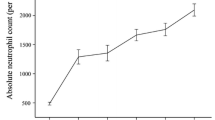Abstract
Although cyclosporine (CsA) is a key drug in the treatment of acquired aplastic anemia (AA), the role of single-agent therapy with CsA remains unclear. To determine the efficacy of CsA in the treatment of AA, we treated 38 AA patients with CsA alone and followed up the patients for 6 months to 16 years. Twenty patients (53%) achieved either a partial or complete remission within 1 year of starting CsA therapy. Thirteen (81%) of 16 patients who showed an increase in the reticulocyte count of >20 x 109/L within 2 months achieved remission, whereas the response rate was only 32% in patients who failed to show such an increase in the reticulocyte count. The actuarial overall survival and failure-free survival rates at 5 years were 91% and 37%, respectively. These data indicate that CsA alone can achieve a sustained remission in approximately 40% of AA patients, with a low probability of inducing secondary clonal diseases. Given its low toxicity and because the effectiveness of CsA can be judged within 2 months of therapy, CsA may be the first drug of choice at outpatient clinics for AA patients not requiring transfusions.
Similar content being viewed by others
References
Hinterberger-Fischer M, Hocker P, Lechner K, Seewann H, Hinterberger W. Oral cyclosporin-A is effective treatment for untreated and also for previously immunosuppressed patients with severe bone marrow failure.Eur J Haematol. 1989;43:136–142.
Leonard EM, Raefsky E, Griffith P, Kimball J, Nienhuis AW, Young NS. Cyclosporine therapy of aplastic anaemia, congenital and acquired red cell aplasia.Br J Haematol. 1989;72:278–284.
Gluckman E, Esperou-Bourdeau H, Baruchel A, et al. Multicenter randomized study comparing cyclosporine-A alone and antithy-mocyte globulin with prednisone for treatment of severe aplastic anemia.Blood. 1992;79:2540–2546.
Frickhofen N, Kaltwasser JP, Schrezenmeier H, et al. Treatment of aplastic anemia with antilymphocyte globulin and methylpred-nisolone with or without cyclosporine. The German Aplastic Anemia Study Group.N Engl J Med. 1991;324:1297–1304.
Bacigalupo A, Broccia G, Corda G, et al. Antilymphocyte globulin, cyclosporin, and granulocyte colony-stimulating factor in patients with acquired severe aplastic anemia (SAA): a pilot study of the EBMT SAA Working Party.Blood. 1995;85:1348–1353.
Rosenfeld SJ, Kimball J, Vining D, Young NS. Intensive immunosup-pression with antithymocyte globulin and cyclosporine as treatment for severe acquired aplastic anemia.Blood. 1995;85:3058–3065.
Marsh J, Schrezenmeier H, Marin P, et al, on behalf of the EBMT Severe Aplastic Anaemia Working Party. Prospective randomized multicenter study comparing cyclosporin alone versus the combination of antithymocyte globulin and cyclosporin for treatment of patients with nonsevere aplastic anemia: a report from the European Blood and Marrow Transplant (EBMT) Severe Aplastic Anaemia Working Party.Blood. 1999;93:2191–2195.
Nakao S, Urabe A, Bessho M, et al. Clinical guide to the diagnosis and treatment of aplastic anemia [in Japanese].Rinsho Ketsueki. 2005;47:27–46.
Camitta BM, Thomas ED, Nathan DG, et al. Severe aplastic anemia: a prospective study of the effect of early marrow transplantation on acute mortality.Blood. 1976;48:63–70.
Camitta BM. What is the definition of cure for aplastic anemia?Acta Haematol. 2000;103:16–18.
Wang H, Chuhjo T, Yasue S, Omine M, Nakao S. Clinical significance of a minor population of paroxysmal nocturnal hemoglobin-uria-type cells in bone marrow failure syndrome.Blood. 2002;100:3897–3902.
Sugimori C, Chuhjo T, Feng X, et al. Minor population of CD55-CD59- blood cells predicts response to immunosuppressive therapy and prognosis in patients with aplastic anemia.Blood. 2006;107:1308–1314.
Nakao S, Takamatsu H, Chuhjo T, et al. Identification of a specific HLA class II haplotype strongly associated with susceptibility to cyclosporine-dependent aplastic anemia.Blood. 1994;84:4257- 4261.
Okamoto M, Shichishima T, Noji H, et al. High frequency of several PIG-A mutations in patients with aplastic anemia and myelodysplastic syndrome.Leukemia. 2006;20:627–634.
Marsh JC, Gordon-Smith EC. Treatment of aplastic anaemia with antilymphocyte globulin and cyclosporin.Int J Hematol. 1995;62:133–144.
de Planque MM, Bacigalupo A, Wursch A, et al. Long-term follow-up of severe aplastic anaemia patients treated with antithymocyte globulin. Severe Aplastic Anaemia Working Party of the European Cooperative Group for Bone Marrow Transplantation (EBMT).Br J Haematol. 1989;73:121–126.
Frickhofen N, Heimpel H, Kaltwasser JP, Schrezenmeier H. Antithymocyte globulin with or without cyclosporin A: 11-year follow-up of a randomized trial comparing treatments of aplastic anemia.Blood. 2003;101:1236–1242.
Ohara A, Kojima S, Hamajima N, et al. Myelodysplastic syndrome and acute myelogenous leukemia as a late clonal complication in children with acquired aplastic anemia.Blood. 1997;90:1009–1013.
Bacigalupo A, Bruno B, Saracco P, et al, for the European Group for Blood and Marrow Transplantation (EBMT) Working Party on Severe Aplastic Anemia and the Gruppo Italiano Trapianti di Midolio Osseo (GITMO). Antilymphocyte globulin, cyclosporine, prednisolone, and granulocyte colony-stimulating factor for severe aplastic anemia: an update of the GITMO/EBMT study on 100 patients.Blood. 2000;95:1931–1934.
Author information
Authors and Affiliations
Corresponding author
About this article
Cite this article
Yamazaki, H., Sugimori, C., Chuhjo, T. et al. Cyclosporine Therapy for Acquired Aplastic Anemia: Predictive Factors for the Response and Long-term Prognosis. Int J Hematol 85, 186–190 (2007). https://doi.org/10.1532/IJH97.06156
Received:
Revised:
Accepted:
Published:
Issue Date:
DOI: https://doi.org/10.1532/IJH97.06156




